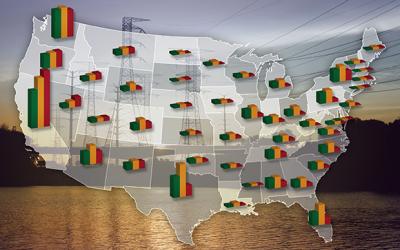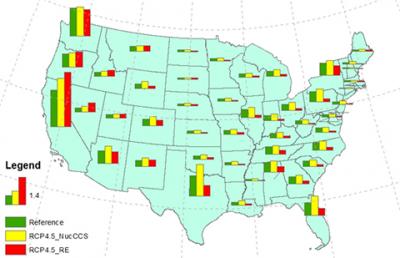Electricity Needs Water: A State-by-State Assessment
The hair dryer label cautions against mixing water and electricity. But water is required to produce the electricity that heats homes, powers industry, and yes, dries hair. To understand the increasing water requirements by U.S. electric power producers, researchers at Pacific Northwest National Laboratory employed a computer model to estimate the state-by-state need through 2095.
“Our detailed accounting of technologies and geographical information through the end of the century will help inform scientific and policy questions at the heart of the U.S. water-energy nexus,” said co-author Dr. Mohamad Hejazi, climate researcher working at the Joint Global Change Research Institute (JGCRI), a partnership between PNNL and the University of Maryland.
In this study, PNNL researchers, working at JGCRI, used the Global Change Assessment Model (GCAM), a technologically detailed model of the economy, energy, agriculture and land use, water, and climate systems. The study’s high level of geographic and technology detail provides a platform to address scientific and policy relevant and emerging issues at the heart of the water–energy nexus. The researchers extended the model to simulate electricity and water systems at the state level (GCAM-USA). They used it to estimate future state-level electricity generation and consumption, and their associated water withdrawals and consumption under a set of seven climate scenarios. These seven scenarios had extensive detail on the generation fuel portfolio and the cooling technology mix, with the associated water-use intensities of both. The scenarios allowed the researchers to investigate the implications of mitigating factors that could play out in the future: socioeconomic development and growing electricity demands, cooling system transitions, adoption of water-saving technologies, climate mitigation policy, and electricity trading options on future water demands of the U.S. electric-sector. All scenarios project a decline in the future electric-sector water withdrawal through the century.
The climate scenarios revealed several water impacts. For instance, in areas such as the Southwest where water can be a scarce resource, the research looked at the trade-off between water withdrawal and water consumption. In another example, drought in 2008 caused several power plants to shut down for days due to lack of cooling water. In this case, the increased use of closed-loop cooling systems would mean less water withdrawal, but relatively high water consumption. And in coastal regions such as California, regulations that require reduction in once-through cooling systems may improve conditions for marine life, but result in greater use of freshwater challenging local watersheds. These changes will also add substantial renovation costs to the power plants in those areas.
The study also shows the impact of two climate mitigation strategies: carbon capture and storage—a.k.a. CSS—and nuclear power. The findings show these strategies to be less favorable on water consumption than others that support renewable energy and water-saving technologies.
Currently, U.S. water requirements for electricity generation account for nearly half the total freshwater withdrawal. With a changing climate, steadily growing electricity demands and limited water supplies in many water-scarce areas poses a significant challenge. While electricity production is likely to increase in the near future, it is less certain how the U.S. electric-sector water demand will change because some energy production technologies are less water intensive than others. This study sheds light on the interactions between the electricity and water systems, both state-wide and nationally.
Generating electrical power is water-intensive, due to its use in thermoelectric cooling. Approximately 41% of the total U.S. freshwater supply is used by the electricity sector. A team led by Department of Energy scientists at the Pacific Northwest National Laboratory’s Joint Global Change Research Institute, used the Global Change Assessment Model (GCAM) to model the electricity and water systems at the state level in the U.S. (GCAM-USA). They used GCAM-USA to estimate future state-level electricity generation, and the associated water withdrawals under a set of seven scenarios with extensive detail on the generation fuel portfolio, cooling technology mix, and associated water use intensities. Employing an integrated modeling approach that captures energy–water interactions at regional and national scales can improve understanding of the key drivers that govern those interactions and the role of national policies. The team found the following impacts through these scenarios:
- Lower withdrawals and higher consumption resulting from the conversion to closed-loop (from open-loop) cooling systems
- Different energy-sector water demand behaviors with alternative pathways to the mitigation goal
- Open trading of electricity benefiting energy-scarce yet demand-intensive states
- State homogeneity under certain driving forces (e.g., climate mitigation and water-saving technologies) but mixed effects under other drivers (e.g., electricity trade)
- A clear trade-off between water consumption and withdrawal for the electricity sector in the U.S.
They also found that climate mitigation strategies supporting renewable energy and water-saving technologies reduced water consumption compared to strategies focusing on nuclear power and carbon capture and sequestration. The study advances existing research by incorporating new technological and geographical details, enhancing our understanding of the complex interactions between the energy and water sectors with future technological transitions.
This research was supported by the Office of Science of the U.S. Department of Energy through the Integrated Assessment Research Program as part of the Regional Integrated Assessment Modeling (RIAM) project (KP1703030). This research leveraged capabilities that were funded by the Platform for Regional Integrated Modeling and Analysis Initiative (PRIMA), which was conducted under the Laboratory Directed Research and Development Program at Pacific Northwest National Laboratory (PNNL).
The Union of Concerned Scientists (UCS) Database is the result of efforts by members of the EW3 Baseline Assessment Team, which included Kristen Averyt (research lead, University of Colorado-Boulder, NOAA Western Water Assessment), Jeremy Fisher (Synapse Energy Economics), Annette Huber-Lee (Tufts University), Aurana Lewis (Duke University), Jordan Macknick (National Renewable Energy Laboratory), Nadia Madden (Union of Concerned Scientists), John Rogers (Union of Concerned Scientists), and Stacy Tellinghuisen (Western Resource Advocates). We are also grateful to Shazia Davis and KC Hallett (National Renewable Energy Laboratory) and Emily Briley and Seth Sheldon (Civil Society Institute) for their contributions.


